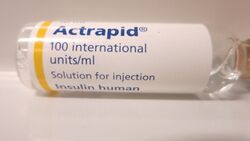Biology:Regular insulin
 A vial of regular human insulin | |
| Clinical data | |
|---|---|
| Trade names | Humulin R, Novolin R, Actrapid, others[1][2] |
| Other names | insulin injection (soluble),[2] neutral insulin,[2] regular human insulin, human insulin (regular), Toronto insulin |
| AHFS/Drugs.com | Monograph |
| MedlinePlus | a682611 |
| License data | |
| Routes of administration | Subcutaneous, intramuscular, intravenous[2] |
| ATC code | |
| Legal status | |
| Legal status | |
| Pharmacokinetic data | |
| Onset of action | 30 minutes |
| Duration of action | 8 hours |
| Identifiers | |
| CAS Number |
|
| ChemSpider |
|
| UNII | |
Regular insulin, also known as neutral insulin and soluble insulin, is a type of short-acting medical insulin.[2] It is used to treat type 1 diabetes, type 2 diabetes, gestational diabetes, and complications of diabetes such as diabetic ketoacidosis and hyperosmolar hyperglycemic states.[5] It is also used along with glucose to treat high blood potassium levels.[6] Typically it is given by injection under the skin, but may also be used by injection into a vein or muscle.[2] Onset of effect is typically in 30 minutes and it typically lasts for 8 hours.[5]
The common side effect is low blood sugar.[5] Other side effects may include pain or skin changes at the sites of injection, low blood potassium, and allergic reactions.[5] Use during pregnancy is relatively safe for the baby.[5] Regular insulin can be made from the pancreas of pigs or cows.[2] Human versions can be made either by modifying pig versions or recombinant technology.[2]
Insulin was first used as a medication in Canada by Charles Best and Frederick Banting in 1922.[7] It is on the World Health Organization's List of Essential Medicines.[8] In 2017, it was the 209th most commonly prescribed medication in the United States, with more than 2 million prescriptions.[9] Versions are also available mixed with longer-acting versions of insulin, such as NPH insulin.[2] In 2020, the combination of human insulin with insulin isophane was the 246th most commonly prescribed medication in the United States, with more than 2 million prescriptions.[10][11]
Medical uses
Regular insulin is used for the long-term management of diabetes.[5] It is the treatment of choice for the two diabetic emergencies diabetic ketoacidosis and hyperosmolar hyperglycemic states.[5] It may also be used in combination with glucose to lower potassium levels in those with hyperkalemia.[6]
Side effects
Side effects may include: low blood sugar levels, skin reactions at the site of injection and low potassium levels among others.[5]
Manufacture
Humulin, one brand name for a group of biosynthetic human insulin products, is synthesized in a laboratory strain of Escherichia coli bacteria which has been genetically altered with recombinant DNA to produce biosynthetic human insulin. Humulin R consists of zinc-insulin crystals dissolved in a clear fluid.[citation needed]
Formulations
It is sold by many manufacturers in a number of different forms.
By Eli Lilly these include:[citation needed]
- Humulin R (REGULAR human insulin injection [rDNA origin]) is a short-acting insulin that has a relatively short duration of activity as compared with other insulins.
- Humulin R Regular U-500 (Concentrated) insulin human injection, USP (rDNA Origin) is a stronger concentration (500 units/mL) of Humulin R.
- Humulin 70/30 (70% human insulin isophane suspension, 30% human insulin injection [rDNA origin]) is a mixture insulin. It is an intermediate-acting insulin combined with the onset of action of Humulin
- Humulin 50/50 (50% human insulin isophane suspension, 50% human insulin injection [rDNA origin]) is a mixture insulin. It is an intermediate-acting insulin combined with the onset of action of Humulin R.
In UK these include:[12]
- Actrapid
- Humulin S
- Insuman Rapid
References
- ↑ "insulin regular human (OTC) – Humulin R, Novolin R". http://reference.medscape.com/drug/humulin-r-novolin-r-insulin-regular-human-999007.
- ↑ 2.0 2.1 2.2 2.3 2.4 2.5 2.6 2.7 2.8 British national formulary : BNF 69 (69th ed.). British Medical Association. 2015. p. 464472. ISBN 9780857111562.
- ↑ 3.0 3.1 "Summary Basis of Decision - Myxredlin". 23 October 2014. https://hpr-rps.hres.ca/reg-content/summary-basis-decision-detailTwo.php?lang=en&linkID=SBD00622&lang=en.
- ↑ "Humulin R U-500- insulin human injection, solution Humulin R U-500 Kwikpen- insulin human injection, solution". 27 June 2022. https://dailymed.nlm.nih.gov/dailymed/drugInfo.cfm?setid=b60e8dd0-1d48-4dc9-87fd-e14675255e8c.
- ↑ 5.0 5.1 5.2 5.3 5.4 5.5 5.6 5.7 "Insulin Human". https://www.drugs.com/monograph/insulin-human.html.
- ↑ 6.0 6.1 "Emergency interventions for hyperkalaemia". The Cochrane Database of Systematic Reviews 2005 (2): CD003235. April 2005. doi:10.1002/14651858.CD003235.pub2. PMID 15846652.
- ↑ Casebook for The Foundation a Great American Secret.. New York: PublicAffairs. 2009. p. 22. ISBN 978-0-7867-3425-2. https://books.google.com/books?id=5RmHA1SAoAgC&pg=PA22.
- ↑ World Health Organization model list of essential medicines: 21st list 2019. Geneva: World Health Organization. 2019. WHO/MVP/EMP/IAU/2019.06. License: CC BY-NC-SA 3.0 IGO.
- ↑ "Insulin Human - Drug Usage Statistics". https://clincalc.com/DrugStats/Drugs/InsulinHuman.
- ↑ "The Top 300 of 2020". https://clincalc.com/DrugStats/Top300Drugs.aspx.
- ↑ "Insulin Human; Insulin Isophane Human - Drug Usage Statistics". https://clincalc.com/DrugStats/Drugs/InsulinHumanInsulinIsophaneHuman.
- ↑ "Human Insulin - Types, Production, Action, History". https://www.diabetes.co.uk/insulin/human-insulin.html.
External links
- "Insulin regular". Drug Information Portal. U.S. National Library of Medicine. https://druginfo.nlm.nih.gov/drugportal/rn/188855-82-5.
- "Insulin". Drug Information Portal. U.S. National Library of Medicine. https://druginfo.nlm.nih.gov/drugportal/rn/11061-68-0.
- "Insulin [Injection, biphasic"]. Drug Information Portal. U.S. National Library of Medicine. https://druginfo.nlm.nih.gov/drugportal/rn/8063-29-4.
 |

